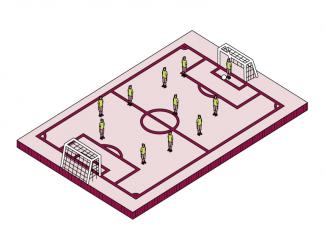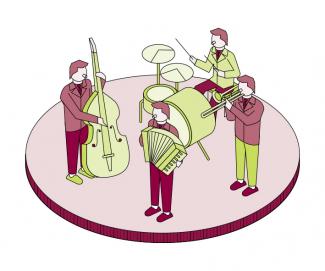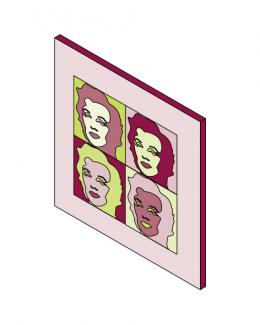
A wave of Atlantic cultural exchange
(Article from l'Edition n.15 - february 2021)
The analysis of cultural exchange between Europe, Africa and the Americas at the core of the Transatlantic Cultures and Americanisation through the arts projects offers a new perspective on globalisation.
“Yesterday’s world was full of differences, whereas tomorrow’s world is veering towards uniformity. The challenge of our time is to understand that the unity of the human race lies in its diversity. […] Diversity is not between cultures, but inherent in the very idea of culture and is therefore a fundamental part of cultures,” wrote Philippe Ratte, a member of UNESCO, in a foreword to the 2010 International Festival of Cultural Diversity hosted by the organisation. As a unit of analysis in itself, the Atlantic area is the perfect geographical framework for understanding the history of these cultural exchanges and sources of cultural diversity. Led by the “Centre d’histoire culturelle des sociétés contemporaines” (Centre for the Cultural History of Contemporary Societies, CHCSC – Université Paris-Saclay, UVSQ), in collaboration with the “Institut des hautes études de l’Amérique latine” IHEAL (The Graduate Institute of Latin American Studies) at Université Sorbonne Nouvelle and the history department and the “École de communication et des arts” (School of Communication and Arts) at the University of Saõ Paolo (Brazil), the Transatlantic Cultures (TRACS) project aims to analyse the way in which intellectual, literary and artistic works have been exchanged between Europe, Africa and the Americas from the end of the 18th century to the present day and the way in which they have contributed to the process of globalisation in a cultural as well as economic, social and political manner.
The contribution of digital humanities to a connected cultural history
TRACS brings together an international team of specialists in humanities, social sciences, arts and literature. In 2021, it will put a digital platform online for transatlantic cultural history. Interactive, freely accessible and published in the four main languages used in the Atlantic area (English, French, Spanish and Portuguese), this platform will list articles and essays on the relations, knowledge, practices and cultural objects resulting from transatlantic exchange. All the major fields of cultural studies are included, such as the performing arts, visual arts, cinema, publishing, education, literature, music, religion and sport, etc. “However, the aim is not to draw up an exhaustive overview of all the cultural exchanges within the Atlantic area over the period under study. Instead, it is to offer a critical reflection on transatlantic exchange and the way in which these exchanges have helped to shape cultural identities,” points out Anaïs Fléchet, a researcher at CHCSC and leader of the TRACS project. One example is football which originated in England at the end of the 19th century and spread throughout Europe, before crossing the Atlantic where it became a key component in the identity of several Latin American countries. “These exchanges sometimes result in the creation of political, linguistic or symbolic boundaries which establish or renew large cultural areas,” adds Anaïs Fléchet. “The Atlantic area has been a testing ground for cultural globalisation as we know it today.”
TRACS has been funded by the “Institut des Amériques” and “Fonds France-Berkeley” since its launch in 2015. Then, in 2016, the French National Research Agency awarded it a four-year programme of collaborative research between public bodies in an international context (PRCI), co-financed by a foreign partner, the Research Foundation of São Paulo (FAPESP). MSH Paris-Saclay also awarded it graduate funding and IDEX Paris-Saclay granted an Alembert chair to welcome researcher Moustafa Sall from the Cheikh Anta Diop University, Dakar (Senegal) to CHCSC and initiate collaborations with African partners as a result.
A new historiography of Americanisation
The project Americanisation through the arts (an extension to TRACS) led by Anaïs Fléchet, Martin Guerpin from the “Laboratoire Synergies langues arts musique” (Synergies Langues Arts Music laboratory, SLAM – Université Paris-Saclay, Université d’Évry), Philippe Gumplowicz from the Arts and Music Department at Université d’Évry and Jean-Claude Yon from the “Institut d’études culturelles et internationales” (Institute for Cultural and International Studies, IECI – Université Paris-Saclay, UVSQ), examines more specifically the processes of Americanisation through cultural transfers between the United States and Europe from the second half of the 19th century to the present day. “It seeks to renew the historiography of Americanisation, which has been approached to a great extent from a military, economic, political and cultural perspective in the broadest sense, but not much from the point of view of the arts,” explains Martin Guerpin. Funded by MSH Paris-Saclay within the context of a Maturation programme (2019-2020), it is part of the continuation of the project “Music and the transition from war”, which had already received funding from the MSH Paris-Saclay (Émergence programme, 2017-2018). “It is by studying these post-conflict periods and different geopolitical areas – from the Franco- Prussian War of 1870 to the Rwandan genocide – and the role of music in maintaining hostility towards the former enemy or in easing tensions, that we realised the very important impact the United States had in Europe after the two world wars – more so than in any other conflict,” adds the musicologist.
Now open to all the arts, the project Americanisation brings together a Franco- American team of cultural historians, musicologists, film historians, specialists in comics, visual arts, design, photography and literature. The first of a series of five webinars dedicated to the project took place in November 2020. In May 2021, the team will meet up for an exploratory workshop at the Royal Northern College of Music in Manchester and, in December 2021, a study day will be held at Princeton University on the theme of popular music. “The idea is to involve more specialists in ‘French studies’ – a field of study which has developed in Britain and the United States in particular and which looks at French culture,’ says Martin Guerpin. A final conference scheduled for autumn 2022 at the Centre Pompidou in Paris will end the project with a musical performance. “An orchestration of an American ballet by Cole Porter based on recovered and rearranged manuscripts, which was presented in Paris in 1923 and for which the original scores have been lost, will be performed. This will give the public an example of the Americanisation of a work of art,” stresses Martin Guerpin. A collective work is also expected at the end of the project.
Key players, points of contact and milestones
Generally speaking, Transatlantic Cultures deals with the key players in transatlantic cultural history – publishers, diplomats or filmmakers, such as Chris Marker who went to film in Africa and Latin America – who have either worked for cultural exchange or have served as intermediaries between the Atlantic’s two shores. The project also addresses contact areas – places where cultural social identities become interwoven, such as port cities, cultural capitals, the great universal exhibitions of the late 19th and early 20th centuries, or more recent major international festivals. “We’re also interested in the material supports which contributed to the exchange, such as books, magazines and plays, and the way in which they circulated, e.g. by plane or by boat There is a temporariness to the circulation, as it is not the same for each period. The history of cultural exchange is also a history of technology,” points out Anaïs Fléchet.
Four key periods stand out. The first, from the early 19th century to the 1850s, coincides with the great Atlantic revolutions and colonial expansion in Africa. “It results in a great circulation of ideas, particularly among the Atlantic elite.” With the arrival of steam travel and ocean liners in the second half of the 19th century, connections between countries became faster and more frequent. It changed the economics of exchange. This was the “steam Atlantic” period. At the beginning of the 20th century, traffic to and from became increasingly important, but was interrupted by the First and Second World Wars. “People and goods circulate less easily during conflicts, transport is limited and states censor the cultural output of enemy countries, such as jazz in Nazi Europe. However, this censorship is never completely watertight and conflicts also generate new movements, linked to the movement of armies or the exile of populations.” The post-war periods coincided with a resumption of exchange, which was quite intense in the 1920s, as well as after 1945. This was the period for the consolidation of mass culture, with the development of cinema, radio and live performances. From the 1960s and 1970s onwards, the most recent period began to take shape – that of the globalisation of the Atlantic area. “It’s becoming one area among others in a much wider globalisation of culture which today extends as far as Asia,” says Anaïs Fléchet.
When music is heard
Martin Guerpin sums up, “The phenomenon of Americanisation through the arts began at the end of the 19th century, with the Universal Exhibition in Chicago in 1893 and the first ‘American’ shows put on in Paris during the Belle Époque. The time frame during which Americanisation took place, however, is different according to the type of art.” Paris remained an important centre of artistic output in the visual arts during the first half of the 20th century. Things changed in the 1950s and 1960s with the advent of Pop Art. While literature remained untouched for a long time (interest in American literature is quite recent), the phenomenon affected music and film more thanks to new media developments in the arts after the Second World War. “When jazz arrived in Europe in the 1920s, it caught the interest of many critics, writers and composers who saw a new modernity in the music and reappropriated it,” points out Martin Guerpin. “Darius Milhaud, for example, incorporated the rhythmic elements and melodic formulas from jazz and blues in a fugue piece for his ballet ‘The Creation of the World’.” Despite some resistance from those who saw it as a threat to the French operetta tradition, jazz became all the rage in France and in the 50s and 60s was played on major national radio stations. Jazz then gave way to rock and “yéyé”. “Since the 2000s, American classical music and operetta, or music hall, have been rediscovered in France following the decline of the European avant-garde and university exchanges in particular,” concludes Martin Guerpin.
Sometimes the influences are reciprocal and Americanisation and Europeanisation become merged. Hollywood music is an example. It was partly created thanks to the scores of New Wave French composers – key figures such as Georges Delerue, Maurice Jarre and Michel Legrand. Before them, however, Jewish composers from Central and Eastern Europe (Germans, Austrians, Hungarians and Ukrainians) who were exiled to the United States after their escape from Nazism in the 1930s had already introduced a new film aesthetic to Hollywood. Hired by the studios, they contributed to the creation of “Hollywood symphonism” – the sound so characteristic of film productions of the era. Interpenetration is therefore strong in the Atlantic area and can be seen in cultural, sporting and culinary practices. “Dissemination is sometimes linked to the history of great population migrations which allow cultures to travel. This is how the art of pizza making has become a part of certain districts in New York, Boston and Buenos Aires with the arrival of Italian emigrants at the end of the 19th century,” points out Anaïs Fléchet. Such dissemination also results in a type of three-way exchange. “For example, at the start of the 20th century, Latin music enjoyed great popularity in Paris. The city became the cultural capital of the Atlantic area and attracted Latin American musicians from Argentina, Brazil and even New York. The tango gained popularity there before the First World War. And it was in Paris that Brazilian musicians were introduced to jazz in the aftermath of the conflict.”
Culture as a means of promotion
Both projects also address cultural diplomacy or “soft power”, i.e. the way in which states, particularly from the 20th century onwards, set up structures to promote their own culture. In fact, France is a pioneer in this field. “Very early on, French political leaders felt a ‘fear of decline’, which led them to develop an innovative cultural diplomatic policy. Even if its competitors (the United Kingdom, Germany and the United States) economically outpaced France, it could still claim cultural leadership. France was also the first to set up specific structures to develop its cultural activities abroad, such as the ‘Association française d’action artistique’ (French Association for Artistic Action) in 1920 which has since become the ‘Institut français’,” says Anaïs Fléchet. The distribution of American films in France was also subject to controls and international agreements, including the Blum-Byrnes agreement signed in 1946, in which the United States undertook to provide substantial financial assistance to France in exchange for favourable conditions for the distribution of American films.
After the Second World War and in the context of the Cold War, all the major powers began to use soft power. “As this was an ideological conflict, each side tried to demonstrate its superiority to the other, and this also included culture. Ministries of Foreign Affairs financed tours by musicians and ballet companies to further a country’s geopolitical or economic interests.” However, soft power was not just the preserve of the major powers. Latin American countries, such as Chile, Argentina and Brazil, have also used it. “Brazilian footballer Pele, for example, went on tours financed by Brazilian diplomacy to promote the country internationally.”
Although governments sometimes stimulate or repress cultural exchange, these interventions do not lead to minimising the role played by cultural activities. “It was dance hall managers who organised the first tours of jazz musicians in France because this was what young people danced to,” points out Martin Guerpin. “Cultural history can also be understood through the conquest of markets,” adds Anaïs Fléchet. An illustration of this is the fact that whole sections of the highly internationalised publishing market are today controlled by large companies and cinema is dominated by private distributors and operators.
The history of cultural exchange is far from over. However, with the rise of South-East Asia, the world is today more multi-polar, and the sinicisation of the world economy is changing the state of play. “Nevertheless, we still do not see the emergence of a phenomenon equivalent to Americanisation with Chinese cultural products or artistic genres. Paradoxically, although it has a very rich and ancient musical and literary tradition, China is not yet focusing on this. Only time will tell if this changes,” suggests Martin Guerpin.



